27 June 2016
More than a quarter of a century ago, a brother and sister embarked on a journey to start a food-related venture, following in the footsteps of their parents before them. They decided to make handcrafted pralines. Their ambition, passion and drive for continuous improvement led them in search of the very best cocoa beans. They aimed for the stars and knocked on the door of one of the world’s best known chocolate makers. As fate would have it, they were turned away; almost ridiculed. Unrelenting in their resolve, the sister honed her chocolate making skills with bean to bar makers throughout Europe while the brother ventured the tropics in search of the world’s finest cocoa beans. The brother and sister are Alessio and Cecilia Tessieri.
Today, Cecilia has cemented her status on the world chocolate stage, as the world’s first female chocolatier. And their Italian chocolate company, Amedei, has been propelled to global chocolate stardom, receiving multiple prized Chocolate Academy Golden Bean awards. To top off these achievements, the brand Amedei has become synonymous with the Chuao and Porcelana, the very finest Criollo cocoa beans that money can buy!
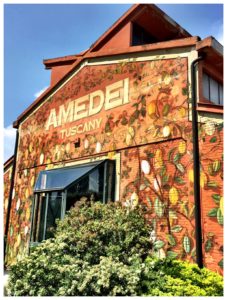 With this knowledge in mind, I made the extra effort to visit and attend a chocolate “tour” of this highly acclaimed chocolate maker, with hubby in tow. The Amedei HQ and chocolate factory is located outside the little known town of Pontedera, Southeast of Pisa, in the Tuscan Chocolate Valley. After some missed turns and u-turns along the way, we finally arrive for our tour, without a moment to spare.
With this knowledge in mind, I made the extra effort to visit and attend a chocolate “tour” of this highly acclaimed chocolate maker, with hubby in tow. The Amedei HQ and chocolate factory is located outside the little known town of Pontedera, Southeast of Pisa, in the Tuscan Chocolate Valley. After some missed turns and u-turns along the way, we finally arrive for our tour, without a moment to spare.
The first thing that greets all visitors to the building is the attractive facade – red brick with painted images of cocoa trees and pods, and colours reflecting the beauty of Tuscany. Our lovely guide, Delitta, is there to greet us and leads us to the tasting room. The room is beautifully decorated with several shelves of Amedei’s chocolate ranges, painted walls and posters of their chocolate making process, and two comfortable Victorian sofas to the back of the room. In the middle sits a long dining table, decked out with table linen and sparkling tableware. The table is set for two people, with a plate each of 5 napolitains (squares).
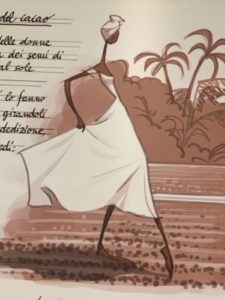 Delitta starts our chocolate journey by taking us through the explanatory video of their chocolate making process, pausing to show us the cocoa pods or cabosses preserved in large jars and letting us experiment with the different smells and tastes of roasted cocoa beans from various tropical origins. According to Delitta, what differentiates Amedei from its competition are the 12 micron fine sieve used to separate the crushed cocoa nibs, which gives rise to a smoother mouthfeel, and the extended duration of conching (72 as opposed to 42 hours), which further develops the flavour, smell and texture of the working chocolate.
Delitta starts our chocolate journey by taking us through the explanatory video of their chocolate making process, pausing to show us the cocoa pods or cabosses preserved in large jars and letting us experiment with the different smells and tastes of roasted cocoa beans from various tropical origins. According to Delitta, what differentiates Amedei from its competition are the 12 micron fine sieve used to separate the crushed cocoa nibs, which gives rise to a smoother mouthfeel, and the extended duration of conching (72 as opposed to 42 hours), which further develops the flavour, smell and texture of the working chocolate.
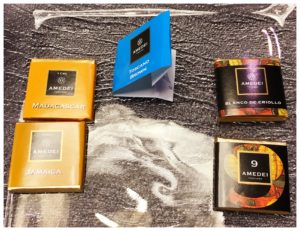 We then progress to the highly anticipated component of the tour, the tasting. We take our time to smell each napolitain, snap off a small piece and let it melt on our tongues. We start with the Toscana brown – smooth mouthfeel and taste of chocolate, minus the long enduring finish of typical chocolate. Delitta tells us that good chocolate should not have a long finish, unlike good wine. After a quick rinse of the palate, Madagascar is next. I detect fruity notes, with hints of toastiness. The Jamaica is punchier; accents of fruits with a caramel-like finish. The anticipation is building as I unwrap the Blanco Di Criollo. It smells slightly different and the taste – like none that I’ve experienced! My tastebuds tell me that I’m eating berries and plums. None of the typical chocolate flavours. By the fifth napolitain, my brain has gone into over-drive. As I unwrap the “9”, Delitta tells us that it’s made of a blend of cocoa beans from 9 plantations. Once again, the smell is slightly different. The flavour, well……imagine a plate of mushrooms with berries. Hubby looks at me. I can tell in that moment that he will never eat chocolates the same way again.
We then progress to the highly anticipated component of the tour, the tasting. We take our time to smell each napolitain, snap off a small piece and let it melt on our tongues. We start with the Toscana brown – smooth mouthfeel and taste of chocolate, minus the long enduring finish of typical chocolate. Delitta tells us that good chocolate should not have a long finish, unlike good wine. After a quick rinse of the palate, Madagascar is next. I detect fruity notes, with hints of toastiness. The Jamaica is punchier; accents of fruits with a caramel-like finish. The anticipation is building as I unwrap the Blanco Di Criollo. It smells slightly different and the taste – like none that I’ve experienced! My tastebuds tell me that I’m eating berries and plums. None of the typical chocolate flavours. By the fifth napolitain, my brain has gone into over-drive. As I unwrap the “9”, Delitta tells us that it’s made of a blend of cocoa beans from 9 plantations. Once again, the smell is slightly different. The flavour, well……imagine a plate of mushrooms with berries. Hubby looks at me. I can tell in that moment that he will never eat chocolates the same way again.
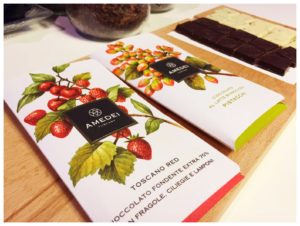 As we are halfway through the napolitains, a middle aged lady in white uniform wheels in a trolley with the Toscana Red and White Milk Chocolate with pistachios, neatly snapped into individual squares. These are next on the tasting list. We start with the White Milk Chocolate with pistachios. As you know by now, I’m no fan of white chocolate. But Delitta convinces me to take a bite; it’s one of her favourites. I find it to be surprisingly pleasant. Not too sweet and the smooth white chocolate pairs perfectly well with the pistachios. I much prefer the Toscana Red, the perfect marriage of dark chocolate with dried red berries. Weeks later, my brother sends me a note to inform me that he’d had some and “this chocolate was very good?”.
As we are halfway through the napolitains, a middle aged lady in white uniform wheels in a trolley with the Toscana Red and White Milk Chocolate with pistachios, neatly snapped into individual squares. These are next on the tasting list. We start with the White Milk Chocolate with pistachios. As you know by now, I’m no fan of white chocolate. But Delitta convinces me to take a bite; it’s one of her favourites. I find it to be surprisingly pleasant. Not too sweet and the smooth white chocolate pairs perfectly well with the pistachios. I much prefer the Toscana Red, the perfect marriage of dark chocolate with dried red berries. Weeks later, my brother sends me a note to inform me that he’d had some and “this chocolate was very good?”.
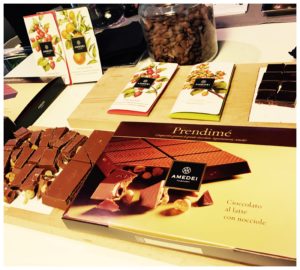 The same lady comes in again, this time bearing a trolley of the whole block of Prendime, neatly snapped into rectangles. It’s literally a 500 gram block of milk chocolate, with whole hazelnuts. The milk chocolate is tasty, with a very smooth mouthfeel, and those hazelnuts – wow! I could eat a whole bowl of them. Delitta informs us that all the ingredients in Amedei chocolates, aside from the cocoa beans, are sourced locally from within Italy. The pistachios come from Bronte, a town in Sicily, and the hazelnuts, the Tonda Gentile Trilobata, come from the Piedmont region.
The same lady comes in again, this time bearing a trolley of the whole block of Prendime, neatly snapped into rectangles. It’s literally a 500 gram block of milk chocolate, with whole hazelnuts. The milk chocolate is tasty, with a very smooth mouthfeel, and those hazelnuts – wow! I could eat a whole bowl of them. Delitta informs us that all the ingredients in Amedei chocolates, aside from the cocoa beans, are sourced locally from within Italy. The pistachios come from Bronte, a town in Sicily, and the hazelnuts, the Tonda Gentile Trilobata, come from the Piedmont region.
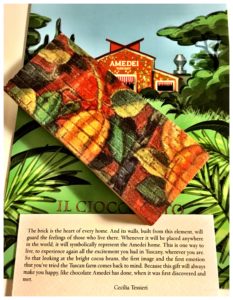
At the conclusion of the tour, we decide that we must purchase some chocolates to take home with us, including the highly acclaimed Porcelana and Chuao (more on these later). Hubby is just as enthused as I am. Delitta presents us with a gift and urges us to unwrap it. We oblige. The gift is a painted red brick with a lovely note that explains the symbolic meaning of the brick, and its association with Amedei and Tuscany. I particularly love the following lines, which accurately sum up our Amedei experience:
This is one way to live, to experience again all the excitement you had in Tuscany, wherever you are………
Because this gift will always make you happy, like chocolate Amedei has done, when it was first discovered and met.
Does this rate as an ultimate chocolate experience? A most definitive YES – for imparting in hubby and I a heightened level of appreciation for the skills and creativity of bean to bar artisans, and the unique tastes and flavour characteristics of the sometimes unsung heroes in chocolates, the cocoa beans! Chocolates will never taste the same again…
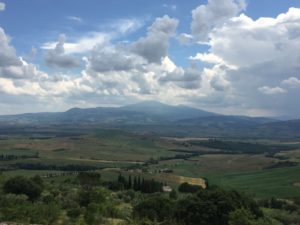 Ciao bella e bello (hello beautiful and handsome)! I’ll admit, I have been neglecting this blog for the past several weeks. But I have the best excuse. Hubby and I have been immersed in the beauty of nature, in all its grandeur and glory. From the Italian deep blue glacial Lago di Como (Lake Como), to the UNESCO heritage rolling green hills and meadows, interspersed with orange hues of summer, and medieval towns of the awe inspiring Toscana (Tuscany). The weather could have been better, but it did little to dampen our enjoyment of this heaven for food, wine and nature lovers.
Ciao bella e bello (hello beautiful and handsome)! I’ll admit, I have been neglecting this blog for the past several weeks. But I have the best excuse. Hubby and I have been immersed in the beauty of nature, in all its grandeur and glory. From the Italian deep blue glacial Lago di Como (Lake Como), to the UNESCO heritage rolling green hills and meadows, interspersed with orange hues of summer, and medieval towns of the awe inspiring Toscana (Tuscany). The weather could have been better, but it did little to dampen our enjoyment of this heaven for food, wine and nature lovers.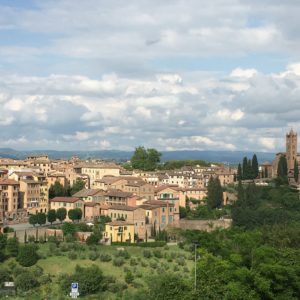 A special thanks to hubby for chauffeuring us around throughout our adventures, as we visited many beautiful and historical Etruscan and Roman towns accessible only through heart-stoppingly narrow and winding country roads, and got lost in remote locations that even GPS and Google maps struggled to locate.
A special thanks to hubby for chauffeuring us around throughout our adventures, as we visited many beautiful and historical Etruscan and Roman towns accessible only through heart-stoppingly narrow and winding country roads, and got lost in remote locations that even GPS and Google maps struggled to locate.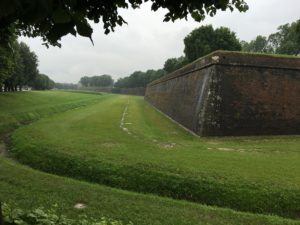 Lucca boasts a monumental fortress that encircles the centro storico (old town), built around the 16th and 17th centuries, and remains intact till this present day. Standing twelve metres high and 4.2km long, the ramparts are lined with matured trees and a central path for walkers, runners and cyclists, looking down onto the centro storico and up to the Apuane Alps in the distance. The town is also the birth home of the operatic maestro, Giacomo Puccini.
Lucca boasts a monumental fortress that encircles the centro storico (old town), built around the 16th and 17th centuries, and remains intact till this present day. Standing twelve metres high and 4.2km long, the ramparts are lined with matured trees and a central path for walkers, runners and cyclists, looking down onto the centro storico and up to the Apuane Alps in the distance. The town is also the birth home of the operatic maestro, Giacomo Puccini. The town itself is fairly flat, with cobbled streets, beautiful piazzas and a mix of Romanesque and Renaissance architectural constructs. An added plus is the restricted traffic access within the centro storico, making it pleasantly walkable and accessible to bicycles. Despite the intermittently wet weather, we spent the day cycling through the cobbled streets, discovering the history, architectural wonders and culinary delights that Lucca had to offer – a feast for all senses!
The town itself is fairly flat, with cobbled streets, beautiful piazzas and a mix of Romanesque and Renaissance architectural constructs. An added plus is the restricted traffic access within the centro storico, making it pleasantly walkable and accessible to bicycles. Despite the intermittently wet weather, we spent the day cycling through the cobbled streets, discovering the history, architectural wonders and culinary delights that Lucca had to offer – a feast for all senses!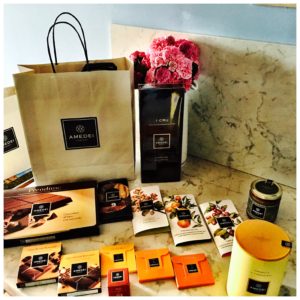 And what about the chocolates, you may ask? Of course, they weren’t forgotten. We braved the unknown to discover the Tuscan Chocolate Valley. Located between Pisa and Prato to the east, and Pontedera to the south, this Valley boasts some of Italy’s best known chocolate makers. These locations were a challenge to find – situated outside of main towns along narrow, meandering country roads that even the GPS and Google maps struggled with. However, with hubby’s patience and skilled driving, and the combined navigational input from yours truly, we triumphantly found our way to Amedei, Torrefazione Trinci, Slitti Cioccolato e Caffe and Roberto Catinari. You’ll have to wait with bated breath to find out about my Tuscan chocolate adventures:)
And what about the chocolates, you may ask? Of course, they weren’t forgotten. We braved the unknown to discover the Tuscan Chocolate Valley. Located between Pisa and Prato to the east, and Pontedera to the south, this Valley boasts some of Italy’s best known chocolate makers. These locations were a challenge to find – situated outside of main towns along narrow, meandering country roads that even the GPS and Google maps struggled with. However, with hubby’s patience and skilled driving, and the combined navigational input from yours truly, we triumphantly found our way to Amedei, Torrefazione Trinci, Slitti Cioccolato e Caffe and Roberto Catinari. You’ll have to wait with bated breath to find out about my Tuscan chocolate adventures:) From top to bottom: The UNESCO heritage listed Val D’ Orcia (Valley of the River), in the heart of Toscana; The picture perfect, Etruscan-built medieval hilltop city of Siena; One aspect of Lucca’s imposing Renaissance fortress; Lucca’s Piazza Anfiteatro, named after the Roman amphitheatre that it was built on; A teaser of my Tuscan chocolate adventures; The majestic Lago di Como, dotted with idyllic lakeside towns.
From top to bottom: The UNESCO heritage listed Val D’ Orcia (Valley of the River), in the heart of Toscana; The picture perfect, Etruscan-built medieval hilltop city of Siena; One aspect of Lucca’s imposing Renaissance fortress; Lucca’s Piazza Anfiteatro, named after the Roman amphitheatre that it was built on; A teaser of my Tuscan chocolate adventures; The majestic Lago di Como, dotted with idyllic lakeside towns.